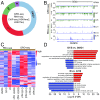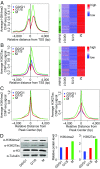Transcriptional landscape of the human cell cycle
- PMID: 28289232
- PMCID: PMC5380023
- DOI: 10.1073/pnas.1617636114
Transcriptional landscape of the human cell cycle
Abstract
Steady-state gene expression across the cell cycle has been studied extensively. However, transcriptional gene regulation and the dynamics of histone modification at different cell-cycle stages are largely unknown. By applying a combination of global nuclear run-on sequencing (GRO-seq), RNA sequencing (RNA-seq), and histone-modification Chip sequencing (ChIP-seq), we depicted a comprehensive transcriptional landscape at the G0/G1, G1/S, and M phases of breast cancer MCF-7 cells. Importantly, GRO-seq and RNA-seq analysis identified different cell-cycle-regulated genes, suggesting a lag between transcription and steady-state expression during the cell cycle. Interestingly, we identified genes actively transcribed at early M phase that are longer in length and have low expression and are accompanied by a global increase in active histone 3 lysine 4 methylation (H3K4me2) and histone 3 lysine 27 acetylation (H3K27ac) modifications. In addition, we identified 2,440 cell-cycle-regulated enhancer RNAs (eRNAs) that are strongly associated with differential active transcription but not with stable expression levels across the cell cycle. Motif analysis of dynamic eRNAs predicted Kruppel-like factor 4 (KLF4) as a key regulator of G1/S transition, and this identification was validated experimentally. Taken together, our combined analysis characterized the transcriptional and histone-modification profile of the human cell cycle and identified dynamic transcriptional signatures across the cell cycle.
Keywords: GRO-seq; cell cycle; epigenetics; nascent RNA; transcriptional regulation.
Conflict of interest statement
The authors declare no conflict of interest.
Figures





References
-
- Okayama H, et al. Cell cycle control in fission yeast and mammals: Identification of new regulatory mechanisms. Adv Cancer Res. 1996;69:17–62. - PubMed
-
- McGill CJ, Brooks G. Cell cycle control mechanisms and their role in cardiac growth. Cardiovasc Res. 1995;30(4):557–569. - PubMed
-
- Piatelli M, Tanguay D, Rothstein T, Chiles T. Cell cycle control mechanisms in B-1 and B-2 lymphoid subsets. Immunol Res. 2003;27(1):31–52. - PubMed
-
- Schafer KA. The cell cycle: A review. Vet Pathol. 1998;35(6):461–478. - PubMed
Publication types
MeSH terms
Substances
Grants and funding
LinkOut - more resources
Full Text Sources
Other Literature Sources
Molecular Biology Databases

